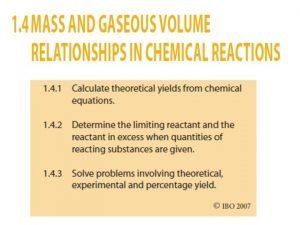Stoichiometry What is Stoichiometry Stoichiometry the study of














- Slides: 14

Stoichiometry

What is Stoichiometry? Stoichiometry: the study of quantitative relationships between amounts of reactants used and amounts of products formed. Stoichiometry is based on the Law of Conservation of Mass. Stoichiometry allows us to determine the amount of substance that is consumed or produced by a reaction. Ex: Consider the equation C 3 H 8 + 5 O 2 4 H 2 O + 3 CO 2 1: 5: 4: 3 We can “read” the molar ratios of the reactants and products. In this way, we can determine how many moles of O 2 are needed to produce a precise amount of CO 2.

How do we use Stoichiometry? How much cake do you need? Stoichiometry allows us to make the right amount of product.

Does this seem right? If we want to make 4 s’mores, we will need to have the proper amounts of all ingredients.

Stoichiometry in action Here are the proper ratios of the ingredients.

Pair Work: Make a 1. With a partner make a list of at Poster least 4 ways you use stoichiometry. 2. Create an illustrated stoichiometry problem. (Use color, make it pop!) 3. Provide a complete answer to your stoichiometry problem. 4. Vote for the poster you think is best from the completed posters.

Molar Ratios The coefficients give us the molar ratios of the reactants and products. Ex: 2 Na + 1 Cl 2 2 Na. Cl Molar ratio of Na: Cl is 2: 1 Molar ratio of Na: Na. Cl is 1: 1

Learning Check C 3 H 8 + 5 O 2 4 H 2 O + 3 CO 2 How many moles of O 2 are needed per C 3 H 8 for the reaction above? How many moles of CO 2 are produced for every mole of O 2 that reacts?

Apply Stoichiometry to Recipes Use the M&M Cookie recipe for the following problems: 1) Double the recipe 2) Triple the recipe 3) Halve the recipe 4) Adjust the recipe to make enough cookies for 20 people to have 5 cookies each 5) Adjust the recipe to make 210 cookies 6) Predict how many cookies you could make if you had a dozen eggs

Stoichiometry Calculations We can convert grams to moles or moles to grams using molar masses. Ex: How many grams is 2 moles of H 2 O?

Stoichiometry Calculations Begin by calculating the molar mass of H 2 O: Molar mass H 2 O = 2(1. 008 g/mol) H + 15. 999 g/mol O 18. 015 g/mol H 2 O

Since we want to know the number of grams in 2 moles, we multiply the molar mass by 2 moles: (2 mol)(18. 015 g/mol) = 36. 03 g H 2 O So 2 moles of H 2 O has a mass of 36. 03 grams.


 Chapter 11 stoichiometry assessment answer key
Chapter 11 stoichiometry assessment answer key Stoichiometry is the study of
Stoichiometry is the study of Stoichiometry is defined as the quantitative study of
Stoichiometry is defined as the quantitative study of độ dài liên kết
độ dài liên kết Thiếu nhi thế giới liên hoan
Thiếu nhi thế giới liên hoan Tia chieu sa te
Tia chieu sa te Chúa yêu trần thế
Chúa yêu trần thế điện thế nghỉ
điện thế nghỉ Một số thể thơ truyền thống
Một số thể thơ truyền thống Sơ đồ cơ thể người
Sơ đồ cơ thể người Số nguyên tố là gì
Số nguyên tố là gì Cong thức tính động năng
Cong thức tính động năng đặc điểm cơ thể của người tối cổ
đặc điểm cơ thể của người tối cổ Tỉ lệ cơ thể trẻ em
Tỉ lệ cơ thể trẻ em Các châu lục và đại dương trên thế giới
Các châu lục và đại dương trên thế giới



























